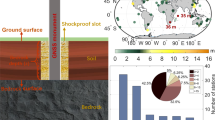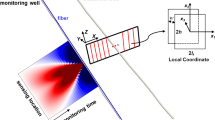Abstract
Zoeppritz equations form the theoretical basis of most existing amplitude variation with incident angle (AVA) inversion methods. Assuming that only primary reflections exist, that is, the multiples are fully suppressed and the transmission loss and geometric spreading are completely compensated for, Zoeppritz equations can be used to solve for the elastic parameters of strata effectively. However, for thin interbeds, conventional seismic data processing technologies cannot suppress the internal multiples effectively, nor can they compensate for the transmission loss accurately. Therefore, AVA inversion methods based on Zoeppritz equations or their approximations are not applicable to thin interbeds. In this study, we propose a prestack AVA inversion method based on a fast algorithm for reflectivity. The fast reflectivity method can compute the full-wave responses, including the reflection, transmission, mode conversion, and internal multiples, which is beneficial to the seismic inversion of thin interbeds. A further advantage of the fast reflectivity method is that the partial derivatives of the reflection coefficient with respect to the elastic parameters can be expressed as analytical solutions. Based on the Gauss–Newton method, we construct the objective function and model-updating formula considering sparse constraint, where the Jacobian matrix takes the form of an analytical solution, which can significantly accelerate the inversion convergence. We validate our inversion method using numerical examples and field seismic data. The inversion results demonstrate that the fast reflectivity-based inversion method is more effective for thin interbed models in which the wave-propagation effects, such as interval multiples, are difficult to eliminate.
















Similar content being viewed by others
References
Aki K, Richards PG (1980) Quantitative seismology: theory and methods. W. H. Freeman and Co., San Francisco
Chen SS, Donoho DL, Saunders MA (2001) Atomic decomposition by basis pursuit. SIAM Review 43(1):129–159
Deng F, McMechan GA (2007) True-amplitude prestack depth migration. Geophysics 72(3):S155–S166. https://doi.org/10.1190/1.2714334
Fatti JL, Smith GC, Vail PJ et al (1994) Detection of gas in sandstone reservoirs using AVO analysis: a 3-D seismic case history using the Geostack technique. Geophysics 59:1362–1376. https://doi.org/10.1190/1.1443695
Fryer GJ (1980) A slowness approach to the reflectivity method of seismogram synthesis. Geophys J Int 63(3):747–758. https://doi.org/10.1111/j.1365-246X.1980.tb02649.x
Fuchs K (1968) The reflection of spherical waves from transition zones with arbitrary depth-dependent elastic moduli and density. J Phys Earth 16:27–41. https://doi.org/10.4294/jpe1952.16.Special_27
Fuchs K, Müller G (1971) Computation of synthetic seismograms with the reflectivity method and comparison with observations. Geophys J Int 23(4):417–433. https://doi.org/10.1111/j.1365-246X.1971.tb01834.x
Jin S (1999) Characterizing reservoir by using jointly P- and S- wave AVO analyses. SEG Tech Program Expand Abstr. https://doi.org/10.1190/1.1821117
Kennett BLN (1974) Reflections, rays, and reverberations. Bull Seismol Soc Am 64(6):1685–1696
Kennett BLN (1983) Seismic wave propagation in stratified media. Cambridge University Press, Cambridge. https://doi.org/10.22459/SWPSM.05.2009
Kennett BLN (2009) Seismic wave propagation in stratified media. ANU E Press, Canberra
Larsen JA (1999) AVO inversion by simultaneous P–P and P–S Inversion. M.Sc. thesis, University of Calgary
Levenberg K (1944) A method for the solution of certain non-linear problems in least squares. Quart Appl Math 2:164–168. https://doi.org/10.1090/qam/1944-02-02
Liu HX, Li JY, Chen XH et al (2016) Amplitude variation with offset inversion using the reflectivity method. Geophysics 81(4):R185–R195. https://doi.org/10.1190/geo2015-0332.1
Lu J, Yang Z, Wang Y et al (2015) Joint PP and PS AVA seismic inversion using exact Zoeppritz equations. Geophysics 80(5):R239–R250. https://doi.org/10.1190/geo2014-0490.1
Lu J, Meng X, Wang Y et al (2016) Prediction of coal seam details and mining safety using multicomponent seismic data: a case history from China. Geophysics 81:B149–B165. https://doi.org/10.1190/geo2016-0009.1
Lu J, Wang Y, Chen J et al (2017) Joint anisotropic AVO inversion of PP and PS seismic data. Geophysics 83(2):1–83. https://doi.org/10.1190/geo2016-0516.1
Liu W, Wang Y-C, Li J-Y et al (2018) Prestack AVA joint inversion of PP and PS waves using the vectorized reflectivity method. Appl Geophys 15(3–4):448–465. https://doi.org/10.1007/s11770-018-0695-4
Luo C, Li XY, Huang GT (2018) Hydrocarbon identification by application of improved sparse constrained inverse spectral decomposition to frequency-dependent AVO inversion. J Geophys Eng 15(5):1446–1459. https://doi.org/10.1088/1742-2140/aab1d6
Mahmoudian F, Margrave GF (2004) Three parameter AVO inversion with PP and PS data using offset binning. SEG Tech Program Expand Abstr. https://doi.org/10.1190/1.1851239
Mallick S, Frazer LN (1987) Practical aspects of reflectivity modeling. Geophysics 52(10):1355–1364. https://doi.org/10.1190/1.1442248
Marquardt DW (1963) An algorithm for least-squares estimation of nonlinear inequalities. J Soc Ind Appl Math 11(2):431–441. https://doi.org/10.1137/0111030
Paige CC, Saunders MA (1982) LSQR: an algorithm for sparse linear equations and sparse least squares. ACM Trans Math Softw (TOMS) 8(1):43–71. https://doi.org/10.1145/355984.355989
Phinney RA, Odom RI, Fryer GJ (1987) Rapid generation of synthetic seismograms in layered media by vectorization of the algorithm. Bull Seismol Soc Am 77(6):2218–2226
Sen MK, Roy IG (2003) Computation of differential seismograms and iteration adaptive regularization in prestack waveform inversion. Geophysics 68(6):2026–2039. https://doi.org/10.1190/1.1635056
Sheen D-H, Tuncay K, Baag C-E et al (2006) Time domain Gauss–Newton seismic waveform inversion in elastic media. Geophys J Int 167(3):1373–1384. https://doi.org/10.1111/j.1365-246X.2006.03162.x
Stewart RR (1990) Joint P and P–SV inversion. The CREWES Project research report 2.
Tarantola A (1986) A strategy for nonlinear elastic inversion of seismic reflection data. Geophysics 51(10):1893–1903. https://doi.org/10.1190/1.1442046
Tiğrek S, Slob EC, Dillen MWP et al (2005) Linking dynamic elastic parameters to static state of stress: toward an integrated approach to subsurface stress analysis. Tectonophysics 397(1–2):167–179. https://doi.org/10.1016/j.tecto.2004.10.008
Wang Y-M, Wang X-P, Meng X-J et al (2011) Pre-stack inversion of wide incident angle seismic data. SEG Tech Program Expand Abstr. https://doi.org/10.1190/1.3627713
Wang Y, Xu X, Zhang Y-G (2016) Ultrasonic elastic characteristics of six kinds of metamorphic coals in China under room temperature and pressure conditions Chinese. J Geophys Ch 59(7):2726–2738. https://doi.org/10.6038/cjg20160735
Weglein AB, Hsu S-Y, Terenghi P et al (2011) Multiple attenuation: recent advances and the road ahead. Lead Edge 30(8):864–875. https://doi.org/10.1190/1.3626494
Xu T, Zhang H, McMechan GA (1998) Amplitude compensation of seismic data: application to masking by shallow bright spots. J Seism Explor 7:173–198
Yuan SY, Liu Y, Zhang Z, Luo CM (2019) Prestack stochastic frequency-dependent velocity inversion with rock-physics constraints and statistical associated hydrocarbon attributes. IEEE Geosci Remote Sens Lett 16(1):140–144
Zhang Y, Zhang G, Bleistein N (2003) True amplitude wave equation migration arising from true amplitude one-way wave equations. Inverse Probl 19(5):1113–1138. https://doi.org/10.1088/0266-5611/19/5/307
Acknowledgements
The authors are very grateful to the MWMC Group for processing the seismic data. We would also like to express thanks for the sponsorship of the National Natural Science Foundation of China (Nos 41574126 and U1910205).
Author information
Authors and Affiliations
Contributions
Each author has contributed to the present paper. Jun Lu conceived the idea of this research. Zhen Yang and Jun Lu designed and programmed the codes. Zhen Yang performed the simulation tests. Zhen Yang and Jun Lu applied the method to the field data and analyzed the inversion results. The paper was written by all the authors.
Corresponding author
Ethics declarations
Conflict of interest
The authors declare that they have no conflict of interest.
Appendices
Appendix 1
Tn is the 6 × 6 delta matrix for the nth layer. The elements of Tn are formed from the Dunkin matrix, which is frequency independent. The following is a list of the 16 independent elements of the matrix Tn:
where \(\Gamma =2p^{2} - 1/\beta^{2}\), \(\mu =\rho \beta^{2}\), \(q^{{\text{P}}} = (\alpha^{{{ - }2}} - p^{2} )^{1/2}\), \(q^{{\text{S}}} = (\beta^{{{ - }2}} - p^{2} )^{1/2}\), and \(p = \sin \theta_{p} /\alpha = \sin \theta_{S} /\beta\).
\({\mathbf{T}}_{n}^{ - 1}\) is the inverse matrix of Tn. The elements of \({\mathbf{T}}_{n}^{ - 1}\) are simply a rearrangement of the elements of \({\mathbf{T}}_{n}\):
Appendix 2
Partial derivation of En and Tn
In general, the incident angle of angle gather will be controlled within 90°. Therefore, the vertical slowness and En can be expressed as:
The partial derivative of En with respect to the parameters Mn can be calculated analytically:
where
in which α and β are the P- and S-wave velocities at the nth layer, respectively.
The partial derivatives of Fn-1 and Fn with respect to the parameters Mn can also be calculated analytically:
where
The matrices \(\frac{{\partial {\mathbf{T}}_{n} }}{\partial \alpha }\), \(\frac{{\partial {\mathbf{T}}_{{n{ + }1}} }}{\partial \beta }\), and \(\frac{{\partial {\mathbf{T}}_{{n{ + }1}} }}{\partial \rho }\) contain 16 independent elements.
Rights and permissions
About this article
Cite this article
Yang, Z., Lu, J. Thin interbed AVA inversion based on a fast algorithm for reflectivity. Acta Geophys. 68, 1007–1020 (2020). https://doi.org/10.1007/s11600-020-00448-7
Received:
Accepted:
Published:
Issue Date:
DOI: https://doi.org/10.1007/s11600-020-00448-7




